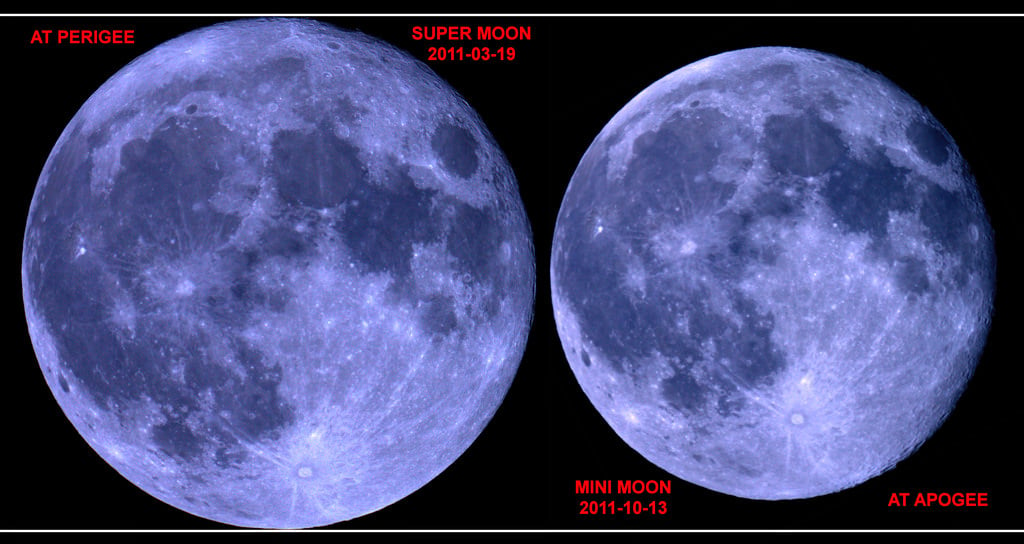Supermoons
.
Blood Moons
. Moons both
Black
and
Blue
… by now, you'd think that there was nothing new under the Sun (or Moon, as it were) when it comes to new unofficial lunar terminology.
Sure, the Moon now seems more colorful than controversial viral dress shades. Love it or loathe it, the Internet can sure set a meme in motion. And this week's Full Moon on Thursday evening offers up one of our faves, as the most distant Full Moon of 2015 occurs on March 5th. Yup, the
Mini-Moon
is indeed once again upon us, a time when the Full Moon appears slightly smaller than usual as seen from the Earth. But can you really tell the difference?
The third Full Moon of the year occurs this week on Thursday, March 5th. Also known as the
Worm or Sap Moon
by the Algonquin tribes of New England, the moment of Full phase occurs at 18:07 Universal Time (UT) or 1:07 PM Eastern Standard Time (EST). This is also just over 10 hours after apogee, which occurs at 7:36 UT/2:36 AM EST. This month's apogee is also an exceptionally distant one, measuring 406,385 kilometres from the center of the Earth to the center of the Moon. This is just 80 kilometres shy of the most distant apogee of 2015 on September 14
th
, which occurs when the Moon is near New phase.
[caption id="attachment_119231" align="alignnone" width="580"]
Can you spy Jupiter next to the waxing gibbous Moon
before
sunset tonite?
- Credit
-
Stellarium.[/caption]
Apogee for the Moon ranges from 404,000 to 406,700 kilometres distant, and the Full Moon appears 29.3 arc minutes across near apogee versus 34.1' across near perigee as seen from the Earth.
This is also the closest apogee near a Full Moon time-wise until January 27
th
, 2032.
What is a Mini-Moon? As with a Supermoon, we prefer simply defining a Mini-Moon as a Full Moon which occurs within 24 hours of apogee. That's much more definitive in our book rather than the cryptic and often cited 'within 90% of its orbit' refrain for Supermoons.
And speaking of which, we've got three 'Super' Full Moons in 2015, with the very closest Super (Duper?) Full Moon occurring within an hour of perigee on September 28
th
during the final total lunar eclipse of the
ongoing tetrad
… what will the spin doctors of the Internet make of this? A 'Super Duper Blood Moon,' anyone?
The path of the Moon this week also takes it towards the Fall equinoctial point in the astronomical constellation of Virgo, as it crosses Leo and nicks the corner of the non-zodiacal constellation Sextans. The
Moon
reaches Full two weeks prior to the Vernal Equinox, which falls this year on March 20
th
. Keep an eye on the Moon, as the
first eclipse of 2015
and this year's only total solar eclipse also occurs just 13 hours prior to the equinox for observers in the high Arctic. (More on that next week).
Can't wait til Thursday? Tonight, observers across Canada, northern Maine, and Europe will see a fine occultation of the star Acubens (a.k.a.
Alpha Cancri
) by the 94% illuminated waxing gibbous Moon:
[caption id="attachment_119230" align="alignnone" width="580"]
The 'shadow footprint' for tonight's occultation of Acubens by the Moon.
- Credit
-
Occult 4.0.1.[/caption]
Alpha Cancri is 175 light years distant, and folks living along the U.S./Canadian border will be treated to a fine grazing occultation as the double star plays hide and seek along the limb of the Moon. This is number 17 in an ongoing series of 21 occultations of the star by the Moon stretching out until June 20th, 2015. There's a wide separation of 11" between the star's A and B components, and there are suspicions from previous lunar occultations that Alpha Cancri A may itself be a double star as well.
We caught a similar occultation of the star Lambda Geminorum by the Moon this past Friday:
Ever feel sorry for moonless Venus? This Wednesday night also offers a chance to spy Venus with a brief 'pseudo-moon,' as +6
th
magnitude Uranus passes just 15' — less than half the apparent diameter of a Full Moon — from brilliant -4
th
magnitude Venus. Neith,
the spurious 18th century moon of Venus
lives! From the vantage point of Venus on March 4
th
, the Earth and Moon would shine at magnitudes -2.3 and +1.5, respectively, and sit about 4 arc minutes apart.
[caption id="attachment_119232" align="alignnone" width="580"]
The rising Full 'Mini-Moon' of March 5th.
- Credit
-
Starry Night Education Software.[/caption]
Does the rising Full Moon look smaller to you than usual this week? While the apparent change in diameter from apogee to perigee is slight, it is indeed noticeable to the naked eye observers. Remember, the Moon is actually about one Earth radius (6,400 kilometres) more
distant
on the local horizon than when it's directly overhead at the zenith. The
Moon is also moving away from us
at a current rate of 1-2 centimetres a year, meaning that Mini-Moons will get ever more distant in epochs hence.
Already,
annular solar eclipses
are currently more common than total ones by a ratio of about 11 to 9. The first annular eclipse as seen from the Earth went unheralded some time about 900 million to a billion years ago, and 1.4 billion years hence, the last total solar eclipse will occur.
[caption id="attachment_119233" align="alignnone" width="580"]
The rising waxing gibbous Moon against the daytime sky. Photo by author.[/caption]
Be sure to get out and enjoy the rising Mini-Moon later this week!
-Send those Mini-Moon pics in to
-Looking for eclipse sci-fi? Check out Dave Dickinson's eclipse-fueled tales
and
Shadowfall
.
 Universe Today
Universe Today
